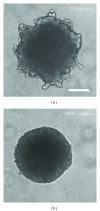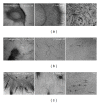Characterization of Porcine Ventral Mesencephalic Precursor Cells following Long-Term Propagation in 3D Culture
- PMID: 23258982
- PMCID: PMC3508616
- DOI: 10.1155/2012/761843
Characterization of Porcine Ventral Mesencephalic Precursor Cells following Long-Term Propagation in 3D Culture
Abstract
The potential use of predifferentiated neural precursor cells for treatment of a neurological disorder like Parkinson's disease combines stem cell research with previous experimental and clinical transplantation of developing dopaminergic neurons. One current obstacle is, however, the lack of ability to generate dopaminergic neurons after long-term in vitro propagation of the cells. The domestic pig is considered a useful nonprimate large animal model in neuroscience, because of a better resemblance of the larger gyrencephalic pig brain to the human brain than the commonly used brains of smaller rodents. In the present study, porcine embryonic (28-30 days), ventral mesencephalic precursor cells were isolated and propagated as free-floating neural tissue spheres in medium containing epidermal growth factor and fibroblast growth factor 2. For passaging, the tissue spheres were cut into quarters, avoiding mechanical or enzymatic dissociation in order to minimize cellular trauma and preserve intercellular contacts. Spheres were propagated for up to 237 days with analysis of cellular content and differentiation at various time points. Our study provides the first demonstration that porcine ventral mesencephalic precursor cells can be long-term propagated as neural tissue spheres, thereby providing an experimental 3D in vitro model for studies of neural precursor cells, their niche, and differentiation capacity.
Figures






Similar articles
-
Neural tissue-spheres: a microexplant culture method for propagation of precursor cells from the rat forebrain subventricular zone.J Neurosci Methods. 2007 Sep 15;165(1):55-63. doi: 10.1016/j.jneumeth.2007.05.019. Epub 2007 May 24. J Neurosci Methods. 2007. PMID: 17588672
-
Leukemia inhibitory factor favours neurogenic differentiation of long-term propagated human midbrain precursor cells.Neurosci Lett. 2009 Oct 30;464(3):203-8. doi: 10.1016/j.neulet.2009.08.050. Epub 2009 Aug 22. Neurosci Lett. 2009. PMID: 19703518
-
Generation of dopaminergic neurons in the adult brain from mesencephalic precursor cells labeled with a nestin-GFP transgene.J Neurosci. 2001 Jun 1;21(11):3895-903. doi: 10.1523/JNEUROSCI.21-11-03895.2001. J Neurosci. 2001. PMID: 11356877 Free PMC article.
-
Recent advances in stem cell neurobiology.Adv Tech Stand Neurosurg. 2003;28:3-89. doi: 10.1007/978-3-7091-0641-9_1. Adv Tech Stand Neurosurg. 2003. PMID: 12627808 Review.
-
Current Developments in Cell Replacement Therapy for Parkinson's Disease.Neuroscience. 2021 May 21;463:370-382. doi: 10.1016/j.neuroscience.2021.03.022. Epub 2021 Mar 26. Neuroscience. 2021. PMID: 33774124 Review.
Cited by
-
The olfactory bulb in newborn piglet is a reservoir of neural stem and progenitor cells.PLoS One. 2013 Nov 21;8(11):e81105. doi: 10.1371/journal.pone.0081105. eCollection 2013. PLoS One. 2013. PMID: 24278384 Free PMC article.
References
-
- Dauer W, Przedborski S. Parkinson’s disease: mechanisms and models. Neuron. 2003;39(6):889–909. - PubMed
-
- Freed CR, Breeze RE, Rosenberg NL, et al. Therapeutic effects of human fetal dopamine cells transplanted in a patient with Parkinson’s disease. Progress in Brain Research. 1990;82:715–721. - PubMed
-
- Freed CR, Greene PE, Breeze RE, et al. Transplantation of embryonic dopamine neurons for severe Parkinson’s disease. The New England Journal of Medicine. 2001;344(10):710–719. - PubMed
-
- Brundin P, Pogarell O, Hagell P, et al. Bilateral caudate and putamen grafts of embryonic mesencephalic tissue treated with lazaroids in Parkinson’s disease. Brain. 2000;123(7):1380–1390. - PubMed
-
- Björklund A, Dunnett SB, Brundin P, et al. Neural transplantation for the treatment of Parkinson’s disease. The Lancet Neurology. 2003;2(7):437–445. - PubMed
LinkOut - more resources
Full Text Sources

